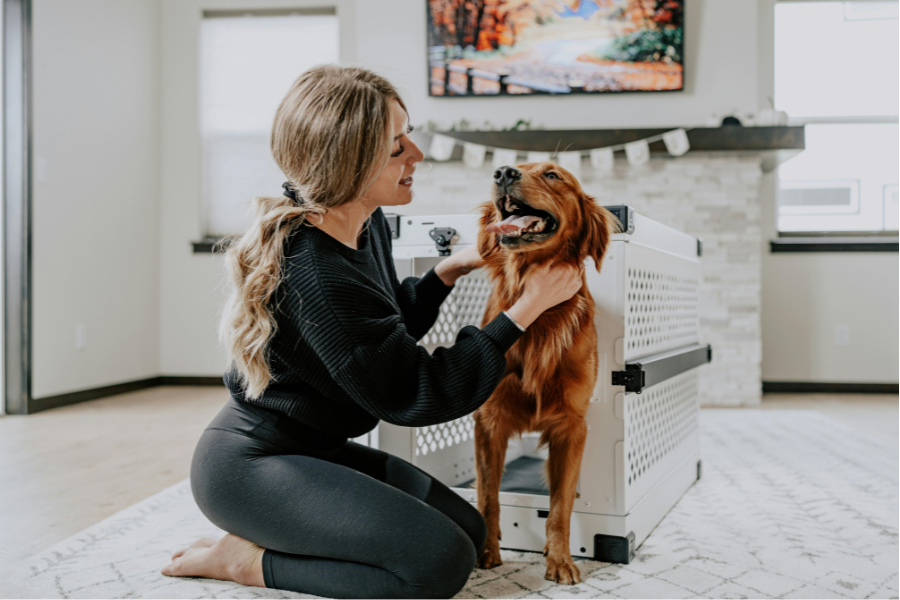
How Long Does Potty Training A Puppy Take? A Brief Guide
- Published on:
- By: ASP Team
If you’ve just brought home a new puppy, one of your first questions is likely: How long does potty training a puppy take? The answer varies by dog, but most puppies take between 4-6 months to be fully house trained. Some may take longer depending on age, breed, and consistency of training. The good news? With the right strategy and tools, you can set your pup up for success from day one.
How long does house training a puppy take compared to crate training?
Crate training and house training go hand-in-hand. A crate provides a safe, cozy space that taps into a dog’s natural instinct to keep their sleeping area clean. When used properly, crate training accelerates the housebreaking process because it helps your puppy learn bladder control, routines, and boundaries. In fact, studies show that even short crate time after training sessions can help dogs better retain what they’ve learned.
How long does it take to housebreak a puppy if I work full-time?
It may take a bit longer if your puppy is alone for long stretches. Puppies under six months old generally can’t hold their bladder for more than a few hours at a time. For those working full-time, consider:
- Hiring a dog walker for midday potty breaks
- Using a puppy playpen with a designated potty pad area
- Sticking to a consistent schedule on mornings, evenings, and weekends
Get Your ESA Today
What are the best tips on potty training puppy owners should know?
- Stick to a schedule: Feed your puppy at the same times daily and take them outside shortly after meals, naps, and play.
- Use a consistent potty spot: Take them to the same place outside each time. It helps reinforce where the bathroom is.
- Reward immediately: Praise and reward with a treat as soon as they go. Timing is key!
- Supervise indoors: If you can’t watch them, crate them. Avoid free roam until they’re more reliable.
- Stay patient: Potty training takes time. Accidents happen. Keep calm and stay consistent.
How to house train a puppy using a crate
Our Crate and Potty Training Fundamentals course lays out every step of the process, starting with how to choose the right crate:
- Size matters: Your dog should be able to stand, turn, and lie down, but not so much room that they can potty in one corner.
- Introduce the crate slowly: Leave the door open and toss in treats to build a positive association. Never force them inside.
- Use cues: Once they’re comfortable, add a command like “crate” or “kennel” and reward them for going in.
- Crate short-term: Begin with a few minutes at a time. Gradually increase duration.
Tips for house training puppy at night
Keep the crate near your bed at first. Your puppy may whine, but don’t let them out right away unless you’re confident they need to go. Reinforce that calm, quiet behavior is rewarded. With repetition, your pup will adjust to nighttime routines.
Toilet training a puppy tips you might not know
- Crating a dog for 20 minutes after training helps them decompress and improves retention.
- If you catch them mid-accident, interrupt calmly, take a breath, and redirect them outside. Avoid yelling.
- If they chew or get into trouble, use a calm tone to lead them to the crate. It’s not a punishment; it’s a safe reset.
How long does it take to potty train a puppy in a multi-pet household?
Potty training in a home with other pets can take a little longer. Your puppy might get distracted or copy older dogs. But with clear boundaries and structure, they’ll catch on.
Ready to master potty training once and for all?
We created Crate and Potty Training Fundamentals to take the guesswork out of the process. It’s a step-by-step video course taught by a seasoned dog trainer and licensed veterinary technician who understands real-world challenges. You’ll learn everything from crate introduction to advanced potty training techniques—all with kindness, consistency, and proven success.
Whether you just want to buy this course solo or become an iTrain Academy member to unlock a full suite of training programs, we’re here to help make training your pup a calmer, easier, and more rewarding experience.
Don’t wait and wonder — start your puppy’s training journey today.

The benefits of an Emotional Support Animal certification and a Psychiatric Service Dog certification are drastically different. Fortunately for you, American Service Pets’ network of active board certified doctor or other licensed mental health providers can help you find the right path to certification. To find out whether you need an ESA or PSD letter, take our easy, three-step Pet Owner Survey!
More Great Resources





